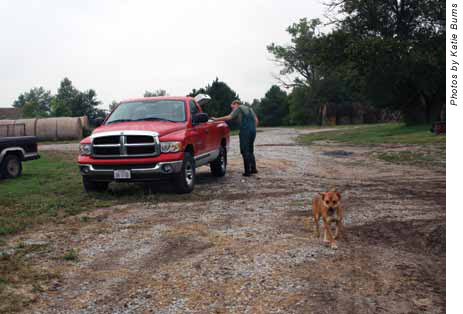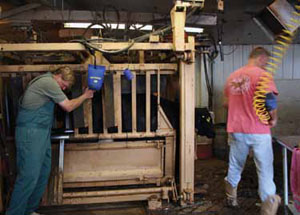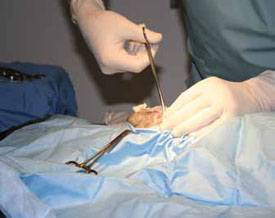Reviving the romance of rural practice
Mist softens the wide green horizons at midmorning on the Blue River Cattle family farm in southeastern Nebraska.
The owner whistles as he herds cows through a chute, gates clanging between animals as they head toward the stall at the end. There, Dr. Ronald D. Wallman stands with his left arm shoulder deep in the rectum of a cow.
"Pregnant," he announces.
The owner opens the stall with another clang, allowing the cow to run into the appropriate pen.

A dozen and a half animals later, Dr. Wallman cleans up and climbs into his red pickup truck. A farm dog races him as he drives down the gravel road toward the rest of his appointments for the day.
Dr. Wallman has been a rural veterinarian for almost three decades, working in mixed animal practice out of Seward, Neb. He can't imagine a better career or location. He loves the time outdoors, the sense of community, and the variety of the caseload.
Nevertheless, he and other rural veterinarians see a need to attract more practitioners to agrarian areas—whether to work with food animals, companion animals, horses, or all of the above. The Academy of Rural Veterinarians as well as many members of the American Association of Bovine Practitioners, including Dr. Wallman, are promoting rural practice to upcoming generations of veterinarians.
The rural lifestyle is the main draw for veterinarians entering rural veterinary practice, according to survey results appearing in two Special Reports in this issue of the JAVMA. The survey's purpose was to assist recruitment and retention efforts by assessing factors that influence veterinarians to enter and leave rural practice.
A survey on rural practice
Dr. Stephen R. McDonald, who served as ARV executive director until recently, first suggested the idea of a survey on rural practice during a discussion on the AABP electronic mailing list. Five other veterinarians volunteered to help with what turned into an extensive online survey. Hundreds of veterinarians and veterinary students provided responses.

Dr. Aurora Villarroel, assistant professor of rural veterinary practice at Oregon State University, is lead author of the reports that summarize the survey results. A key finding is that an interest in rural practice tends to develop early in life but can develop later, she said.
Of survey respondents with an interest in rural practice, 38.3 percent developed the interest before eighth grade, while 12.9 percent developed the interest during veterinary school. Major factors in developing this interest were having relatives with a farm background, having a veterinarian in rural practice as a mentor, or having exposure to rural practice during veterinary school.
Of survey respondents who pursued a career in rural practice, 89.1 percent indicated that the rural lifestyle was an important factor in the decision.
The rural sensibility also is part of the appeal for Dr. Villarroel, who spent much of her childhood on a family dairy farm in Spain.
"I really enjoy the contact with the clients," she said. "Rural clients are different. They are down-to-earth; they're really straightforward. They live in the real world. Animals live, animals die, things go wrong with the weather, and you adapt."
The top two factors that influenced survey respondents to accept a first job in rural practice were the practice's atmosphere and location. Emergency duty and a lack of time off were the top two factors that influenced veterinarians to leave rural practice.
"I don't think any of us likes being on call because we all like to go home and be able to kick back and relax," Dr. Villarroel said. "But I really don't mind, in a way, when I have a calving. I know I'm doing a good deed, especially if I get a live calf."

Rural practice isn't for everyone, noted Dr. McDonald, who co-owns Dry Fork Veterinary Clinic in Henrietta, Texas, with his wife, Dr. Polly S. McDonald.
"The people who stay, I guess they want to be there, more than anything. And I guess they've resolved all the problems they might have had," he said.
"It's kind of like being married. No relationship is perfect, but you modify yourself to fit your relationship."
Lifestyle of a rural practitioner
At Briggs Feedyard near Seward, the sun is shining in the early afternoon. Thousands of cattle roam the lots as a freight train passes by in the distance.
Dr. Wallman heads into a barn for a session of pregnancy checks. Ranch hands simultaneously brand each animal, switch out ear tags, and administer vaccines. Afterward, the ranch hands mount their horses to herd the cattle to the correct pens.
Dr. Wallman grew up in a town about 60 miles from Seward. Most of his relatives lived on farms, and he always liked hunting and being outdoors. When looking at a career book, he thought the job of veterinarian didn't sound too bad.
His career choice led to a good life, Dr. Wallman said. "People do call me 'doc,' and I do drive a big pickup truck, and I do know all the best hunting spots."
Dr. Wallman came to Seward after veterinary college to assist a formerly solo practitioner for a year. He was a solo practitioner himself for six years before finding his first partner, Dr. Jay Wolverton, who handles most of the equine cases. They later mentored a Seward native, Dr. Dan Ellis, through pre-veterinary and veterinary studies. Dr. Ellis joined Seward Animal Hospital after he graduated in 2005.
Dr. Wallman thinks many veterinary students from rural backgrounds want to go into rural practice. One barrier is a lack of job opportunities in rural areas for spouses with professional degrees. On the other hand, Dr. Wallman said, the pay in rural practice is better than veterinary students might think—as are the hours.
Being a solo practitioner was tough, Dr. Wallman admitted. These days, though, he and his partners take turns covering on-call duty and Saturday mornings. They work four-day weeks otherwise.
Hence, Dr. Wallman has time for veterinary and community groups. He has been president of the Nebraska VMA and is an active member of the AABP. He and his wife, Annette, volunteer with their church, 4-H, and civic groups. He is on the city planning commission and the county fair board, and he serves as landscaper for the fairgrounds.
Recruitment and retention
The ARV helps arrange and finance externships to expose veterinary students to rural practice and the rural lifestyle, Dr. McDonald said. Members of the ARV regularly visit veterinary colleges to speak about their careers.

Recently, the ARV partnered with Pfizer to promote rural veterinary practice to undergraduate college students. Working with Pfizer and the National FFA Organization, the ARV also plans to send members to speak at inner-city agricultural high schools.
Dr. McDonald, from a rural background himself, said he wants all young people to consider rural veterinary practice as a viable career option. He and his wife have made a living in rural practice for more than two decades, serving the community by treating every animal species that comes their way.
"The clientele are the best people on earth," Dr. McDonald said. "They appreciate the services, and you have long-term relationships with them."
Dr. Shelley J. Lenz, ARV president and owner of Killdeer Veterinary Clinic in Killdeer, N.D., said the ARV has turned its attention to retention of new rural veterinarians. Members are developing a survival manual for the first years of rural practice. They also support recent graduates and other members by networking via the Internet, on the phone, and in person at meetings.
Dr. Lenz went into rural practice herself mostly to help meet the need for veterinary services in rural areas, despite her urban background and disinterest in working with food animals.
"Anywhere there's food animals, there's people; and anywhere there's people, there's pets; and anywhere there's space, there's horses," Dr. Lenz said.
The solo practitioner enjoys the challenge of providing all types of veterinary services for horses and companion animals, from dental care to emergency care. She likes the sense of community and practicality in rural life.
The AABP provides grants toward student externships in bovine practice or mixed animal practice including cattle.
Dr. John W. Ferry sought to revive the romance of rural practice and country living as AABP president several years ago, and he asked members to share their stories with veterinary students.
Dr. Ferry co-owns a mixed animal practice in Adams, N.Y., with his wife, Dr. Diane P. Ferry. He enjoys living in a one-stoplight town, where he recognizes everyone at church and the grocery store.
"It's also, for me, the lifestyle of living in the country," Dr. Ferry said. "I just love being surrounded by God's creation and taking it in all day long."
He delights in seeing an eagle following a creek in snowfall or the northern lights brightening the night sky.
Dr. Ferry said bovine veterinarians have a responsibility to make sure new associates have a positive experience on the job, especially during the first year. He said practice owners should provide a fair salary and share the better accounts.
Upcoming generations
A number of programs at veterinary colleges are reaching out to students who come from rural backgrounds or have an interest in rural or food animal practice. The federal government and many states as well as the AVMA and American Veterinary Medical Foundation also have created loan-repayment programs for veterinary students who enter rural or food animal practice after graduation.
Many members of the ARV and AABP appreciate these programs as they continue trying to expose more young people to rural practice from grade school through veterinary college.
In addition to his junior partner, Dr. Wallman has influenced at least one other young Seward native pursuing a veterinary career—his daughter, Lindsey, a member of the 2012 class in the new cooperative program between the University of Nebraska and Iowa State University.
As evening is falling at Seward Animal Hospital, a bright lamp illuminates the surgery room. Dr. Wallman and his junior partner lean over an incision in a cat's leg.
Dr. Ellis hopes to pin the cat's broken femur, and Dr. Wallman is willing to try, but the break is at the tip of the femoral head. So Dr. Wallman removes the loose bone fragment and sutures muscle in its place to create a false joint.
The clinic is quiet as Dr. Wallman finishes another day.